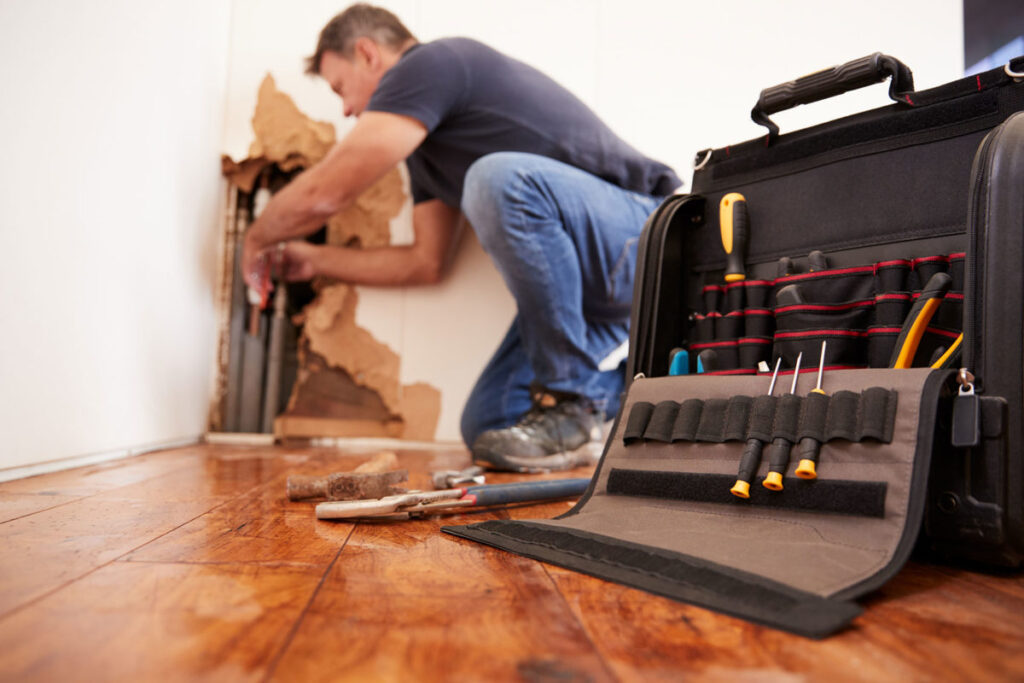Table of Contents:
- Key Takeaways
- Understanding Drywall Water Damage
- Preventative Measures for Protecting Drywall
- Identifying Potential Problems Early
- Taking Action: Drywall Water Damage Repair
- When to Seek Professional Assistance
Key Takeaways:
- Recognize the causes and effects of water damage on drywall to take early action.
- Employ practical strategies for preventing water damage in your home.
- Detect early signs of drywall water damage to avert extensive repairs.
- Understand the appropriate repair steps for drywall water damage or when to call professionals.
Understanding Drywall Water Damage
Drywall, the common material for interior walls and ceilings, is particularly vulnerable to water damage due to its porous nature. Once water makes contact, drywall can begin to break down, compromising your home’s strength, appearance, and even safety. Sources of water damage are often leaks from compromised roofs, windows and doors, and plumbing mishaps, or can be due to flooding incidents. Signs of damage to be aware of include staining, the emergence of a musty odor, or structural deformities, all of which could signal the need for immediate attention and potentially drywall water damage repair.
Preventative Measures for Protecting Drywall
Preventing water damage to drywall begins with consistent vigilance and maintenance. Monitoring areas prone to moisture, such as around sinks, toilets, tubs, and beneath appliances like dishwashers and refrigerators, can reveal issues before they escalate. Proper home sealing, such as ensuring caulking around windows and doors is intact, can guard against external moisture intrusion, and ensuring your gutter and downspout systems are operating correctly can protect your house’s exterior and foundation from water-related problems.
Where possible, employing proactive water mitigation tools such as water sensors or water barriers can alert homeowners to potential issues and help manage the risks effectively. These sensors, placed near potential water sources, are designed to alert you to moisture, offering the chance to address the concern before it spreads to larger portions of the drywall.
Identifying Potential Problems Early
Early detection is the key to limiting the damage water can do to drywall. Regularly inspect your home for any visual signs, such as changes in texture or color of the walls, which might indicate water damage. Ensuring prompt investigation and remediation of these changes can help avert more extensive damage.
Do not ignore subtle signs like a persistent damp or musty smell — this can indicate hidden moisture within the wall cavities. In areas particularly susceptible to moisture, such as bathrooms and kitchens, take additional precautions like ensuring adequate ventilation to prevent condensation buildup, which might go unnoticed and lead to long-term damage.
Taking Action: Drywall Water Damage Repair
If you’ve detected an area of your drywall that has been affected by water damage, the severity of the damage will dictate the appropriate course of action. Minor water damage might be localized enough to dry out the area and apply a sealant, perhaps followed by repainting. More extensive damage, however, where the drywall has become soft, bulging, or crumbling, will generally require cutting out the affected area to prevent potential collapse or mold growth.
After removing damaged sections, a drywall water damage repair may involve replacing the drywall, taping, mudding, and sanding to integrate the repair seamlessly with the surrounding area and repainting to restore the aesthetic appearance. While these steps may be within the scope of a handy DIY enthusiast, larger repairs require precision and an understanding of structural integrity, often making professional services the sensible choice.
When to Seek Professional Assistance
Sometimes a professional should be called in to manage drywall water damage. If the damage is extensive, has led to structural concerns, or there is potential for mold growth, professional services are not only advantageous but often necessary. Contractors specializing in water damage restoration can assess the damage comprehensively, provide appropriate removal and repair services, and ensure complete drying and mold treatment to safeguard your home.
Remember that quick, effective remediation is key to controlling the impact of water damage. Contacting a trusted professional promptly can help speed up recovery, ensuring your home’s integrity and peace of mind.

